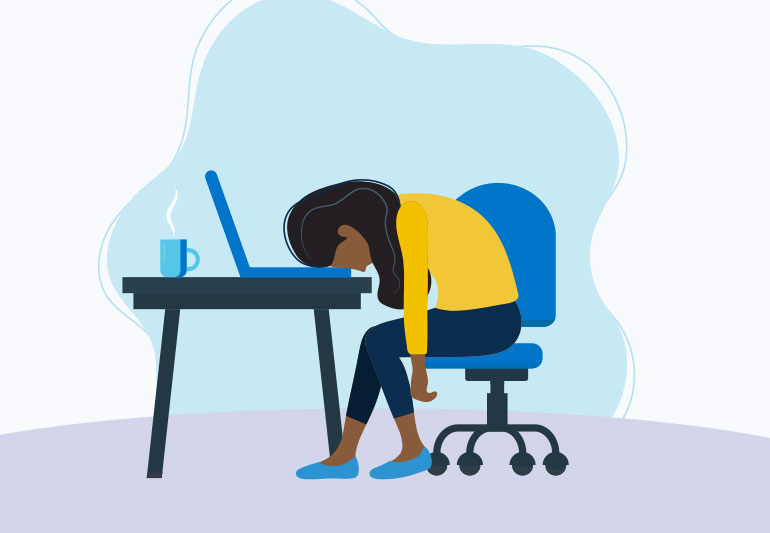Workplace depression is a mental health issue that affects many individuals in their work environment. It can be caused by a variety of factors such as high job demands, low job control, lack of social support, and job insecurity. When left unaddressed, workplace depression can have negative consequences for both the individual and the organization. In this article, we will explore the causes of workplace depression, its symptoms, and how it can be prevented and treated.
Contents
Causes of Workplace Depression
Workplace depression is a complex condition that can be caused by a variety of factors, including both individual and organizational factors. Some of the most common causes of workplace depression are:
- Job Demands: High job demands, such as unrealistic workloads, long working hours, and frequent job changes, can lead to feelings of stress, burnout, and depression. These demands can be especially challenging for individuals who do not have adequate resources or support to manage them effectively.
- Low Job Control: A lack of control over one’s work environment and job tasks can contribute to workplace depression. Individuals who feel like they have little say in how they perform their job or how decisions are made may experience feelings of frustration, helplessness, and low self-esteem.
- Poor Workplace Relationships: Lack of social support and poor relationships with colleagues or supervisors can also contribute to workplace depression. Negative interactions, harassment, and bullying can cause feelings of isolation and rejection, which can lead to depression.
- Job Insecurity: Job insecurity, such as the fear of losing one’s job or uncertainty about future job prospects, can cause significant stress and anxiety. This can lead to depression, particularly if individuals feel like they have little control over their job security.
- Organizational Culture: The culture of an organization can also contribute to workplace depression. For example, a culture that values productivity over employee well-being or that stigmatizes mental health issues can make it challenging for individuals to seek support and feel valued in their workplace.
Symptoms of Workplace Depression

Workplace depression can manifest in a variety of ways, and its symptoms can be physical, emotional, and cognitive. Some of the most common symptoms of workplace depression are:
- Persistent Sadness: Individuals experiencing workplace depression may feel sad, hopeless, and down most of the time. This feeling can persist even when things are going well in their personal life.
- Fatigue and Lack of Energy: A lack of energy and persistent fatigue are common symptoms of workplace depression. Individuals may find it difficult to get out of bed in the morning, to focus on their work, or to complete daily tasks.
- Irritability and Anger: Workplace depression can cause individuals to become irritable, short-tempered, and angry. They may find themselves snapping at colleagues or family members over small issues.
- Cognitive Issues: Depression can affect an individual’s ability to concentrate, remember things, and make decisions. They may experience a lack of motivation or a sense of indecisiveness.
- Physical Symptoms: Depression can also cause physical symptoms such as headaches, muscle tension, digestive problems, and changes in appetite or sleep patterns.
- Social Withdrawal: Individuals experiencing workplace depression may avoid social interactions or isolate themselves from colleagues, friends, and family members. This can lead to feelings of loneliness and further exacerbate their depression.
It is important to recognize these symptoms of workplace depression and seek support from mental health professionals, colleagues, or employee assistance programs. Early intervention can help individuals manage their symptoms and prevent the negative consequences of untreated depression.
Impact of Workplace Depression on Organizations
 Workplace depression can have a significant impact on organizations, affecting employee productivity, job performance, and overall organizational outcomes. Some of the most common impacts of workplace depression on organizations include:
Workplace depression can have a significant impact on organizations, affecting employee productivity, job performance, and overall organizational outcomes. Some of the most common impacts of workplace depression on organizations include:
- Decreased Productivity: Individuals experiencing workplace depression may find it challenging to complete their work tasks efficiently, resulting in decreased productivity. This can lead to missed deadlines, decreased quality of work, and increased workplace errors.
- Increased Absenteeism: Workplace depression can also lead to increased absenteeism, as individuals may take time off work to cope with their symptoms or seek treatment. This can result in decreased productivity, increased workload for other employees, and increased costs for the organization.
- Higher Healthcare Costs: Untreated workplace depression can lead to increased healthcare costs for both the individual and the organization. This includes costs associated with doctor’s visits, medication, and hospitalization, as well as indirect costs such as lost productivity and increased absenteeism.
- Decreased Job Satisfaction: Employees experiencing workplace depression may feel less satisfied with their job and their workplace environment. This can lead to increased turnover rates, decreased employee engagement, and decreased morale among remaining employees.
- Negative Workplace Culture: Untreated workplace depression can also contribute to a negative workplace culture, leading to increased stress, decreased communication, and decreased collaboration among employees. This can have long-term effects on the organization’s culture and its ability to attract and retain talent.
Recognizing the impact of workplace depression on organizations is essential to developing effective prevention and intervention strategies.
Programs To Help Employees Overcome
There are several programs and resources available to employees who are experiencing workplace depression. These programs can provide support, education, and resources to help employees manage their symptoms and improve their mental health. Some examples of programs that can help employees overcome workplace depression include:
- Employee Assistance Programs (EAPs): EAPs are confidential counseling and referral services that provide employees and their families with support for a range of personal and work-related issues, including depression. EAPs can help employees access resources for stress management, coping skills, and other mental health support.
- Mental Health Benefits: Many employers provide mental health benefits as part of their health insurance plans. These benefits can cover the cost of therapy, medication, and other mental health services, making it easier for employees to access the care they need.
- Wellness Programs: Wellness programs can provide employees with resources and support for improving their overall health and well-being, including their mental health. These programs can include resources for stress management, physical activity, and healthy eating, as well as workshops and support groups.
- Flexible Work Arrangements: Flexible work arrangements, such as telecommuting, flexible hours, or job sharing, can help employees manage their work-life balance and reduce stress. This can be especially beneficial for individuals experiencing workplace depression who may need to prioritize their mental health needs.
- Peer Support Programs: Peer support programs, such as support groups or peer counseling programs, can provide employees with a safe and supportive environment to discuss their mental health concerns and connect with others who are experiencing similar challenges.
How Can HR Help In Workplace Depression?

Human Resources (HR) can play a crucial role in addressing workplace depression and promoting a supportive work environment. Some ways HR can help employees with workplace depression include:
- Promoting Awareness and Education: HR can help promote awareness and education around workplace depression by providing resources and information on mental health, including the signs and symptoms of depression and where to access support and treatment.
- Creating a Supportive Workplace Culture: HR can also help create a supportive workplace culture that prioritizes employee well-being and mental health. This can include providing opportunities for employee feedback, offering wellness programs and resources, and promoting a positive work-life balance.
- Offering Confidential Support: HR can offer confidential support to employees who are experiencing workplace depression by providing access to employee assistance programs, mental health benefits, and other resources. They can also facilitate access to mental health professionals or provide referrals to local mental health resources.
- Accommodating Employees’ Needs: HR can help accommodate employees’ needs by offering flexible work arrangements, such as remote work or flexible hours, to help employees manage their symptoms and prioritize their mental health needs.
- Training and Development: HR can also provide training and development opportunities to managers and supervisors to help them recognize and address workplace depression among their team members. This can include training on how to support employees’ mental health, how to recognize the signs and symptoms of depression, and how to facilitate access to mental health resources.
Prevention and Treatment of Workplace Depression
Preventing and treating workplace depression requires a multi-faceted approach that addresses both individual and organizational factors. Some effective strategies for preventing and treating workplace depression include:
- Promoting Work-Life Balance: Employers can help prevent workplace depression by promoting work-life balance. Encouraging flexible working hours, providing opportunities for breaks and relaxation, and discouraging overtime can help employees manage their stress levels and maintain their mental health.
- Creating a Positive Work Environment: A positive work environment can help prevent workplace depression. This includes fostering a culture of support, appreciation, and open communication, as well as providing opportunities for socializing and team-building.
- Providing Employee Support Programs: Employee assistance programs (EAPs) can provide confidential counseling, support, and referrals to mental health professionals for employees who are experiencing workplace depression. These programs can also provide resources for stress management, coping skills, and other mental health support.
- Encouraging Physical Activity: Physical activity has been shown to improve mental health and reduce symptoms of depression. Employers can encourage physical activity by providing gym memberships, promoting lunchtime walks, or organizing company sports teams.
- Offering Treatment Options: When an employee is experiencing depression, employers can offer treatment options such as therapy, medication, or other mental health interventions. This can include providing access to mental health professionals, offering paid leave for therapy sessions, or providing coverage for mental health services through the company’s health insurance plan.
Preventing and treating workplace depression requires a proactive approach from both employees and employers. By taking steps to promote mental health and well-being in the workplace, individuals and organizations can help prevent the negative consequences of workplace depression and promote a healthy and productive work environment.
Conclusion
In conclusion, workplace depression is a serious mental health issue that can have significant consequences for both employees and organizations.
Employers can play a critical role in addressing workplace depression by promoting a supportive work environment. HR can play a crucial role in this process by promoting awareness and education.
By working together to address workplace depression, employers and employees can promote a healthy and productive work environment that supports the mental health and well-being of everyone in the workplace.
Employee wellness programs are the key to improving employee motivation, productivity, and retention. At MantraCare, we have a team of health experts, counselors, and coaches who serve corporate employees with 10+ well-being programs including EAP, Employee Diabetes Reversal, Corporate MSK, Employee Fitness, Corporate Yoga, and Employee meditation
